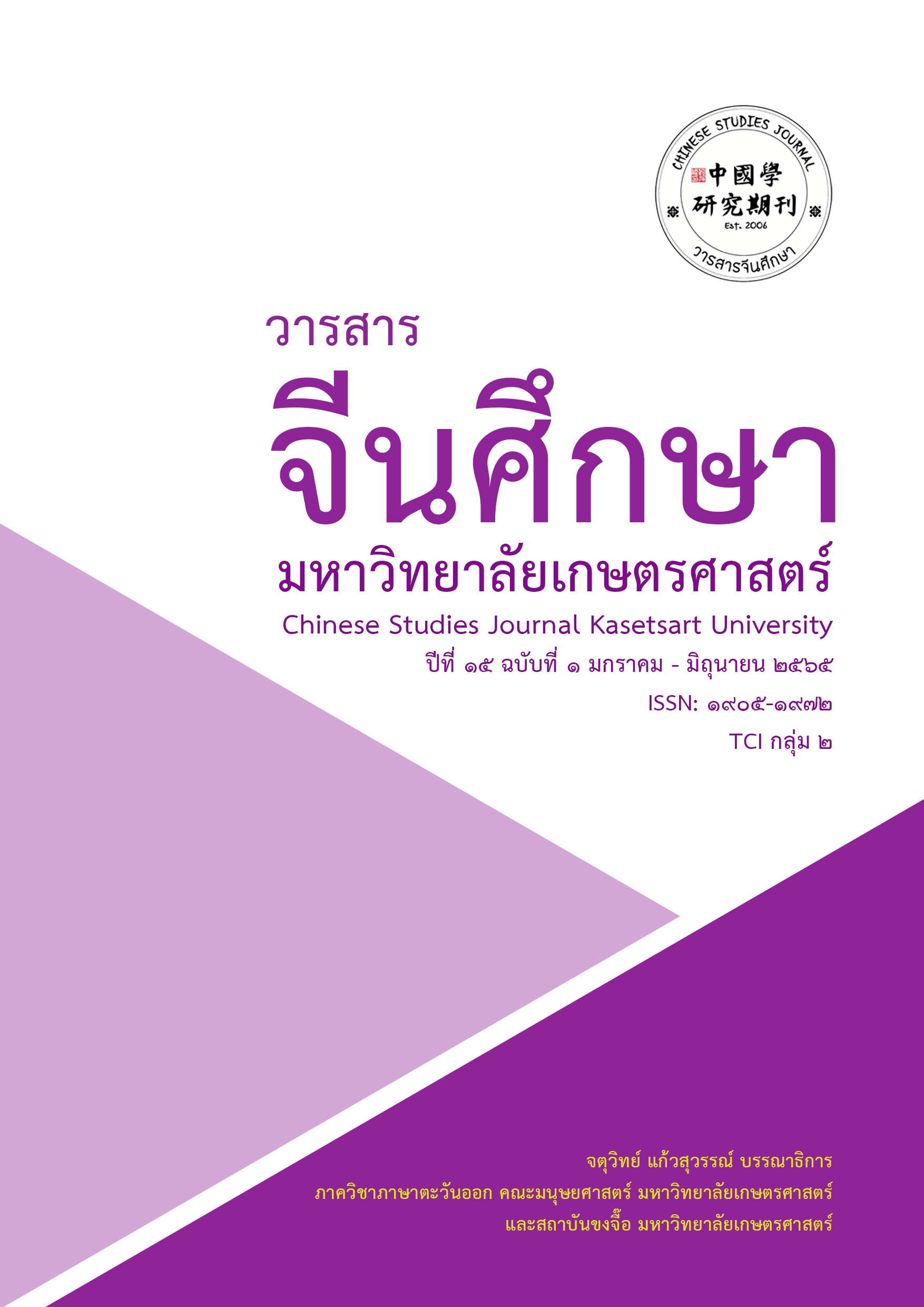Errors Analysis of Chinese translation and Standardization of Thai Public Signs in Thailand การวิเคราะห์ข้อผิดพลาดในการแปลป้ายสาธารณะภาษาจีนและการกำหนดมาตรฐานป้ายสาธารณะในประเทศไทย
Main Article Content
Abstract
With the rapid increase in the number of Chinese tourists in recent years, the Thai government and private companies have added Chinese translations to many signs in public places. Due to the lack of standards for the translation of Chinese signs in Thailand, and the differences in languages and cultures between China and Thailand, the misuse and incorrect translation of Chinese signs in public places are still common in Thailand. These mistakes will have many adverse effects in Thailand. The author draws on previous research experiences, combines the actual situation of the research objects in this article, uses empirical research methods, considers from a functional point of view, obtains translation error corpus in the form of photographs and online search supplements. And the public places’ Chinese Signs or Chinese-Thai comparison signs was collected, such as the signs in Thai stations, streets, shopping malls, and tourist attractions, etc. Then we select several common functional types of signs in public places in Thailand as the research objects, including prompts, warnings, notices, etc. And the error cases were sorted out and the collected signs were analyzed, consist of count the error rate, and analyze the types of wrong use cases and the reasons for mistranslation deeply. Then we classified and analyzed the cause of the error. The adverse effects caused by incorrect signs explained also. Based on these, we put forward suggestions on the standardization of Chinese signs translation from the aspects of translation principles, translation content and translation methods. And we provided principles and suggestions for the future translation of signs in public places. Finally, several practical translation methods and techniques for the translation of signs in public places in Thailand are proposed.
Article Details

This work is licensed under a Creative Commons Attribution-NonCommercial-NoDerivatives 4.0 International License.
ผลงานทางวิชาการที่ลงตีพิมพ์ในวารสารจีนศึกษา มหาวิทยาลัยเกษตรศาสตร์ เป็นลิขสิทธิ์ของผู้เขียนหรือผู้แปลผลงานนั้น หากนำลงในวารสารจีนศึกษาเป็นครั้งแรก เจ้าของผลงานสามารถนำไปตีพิมพ์ซ้ำในวารสารหรือหนังสืออื่นได้โดยมิต้องแจ้งให้ทราบล่วงหน้า แต่หากผลงานที่ได้รับพิจารณานำลงในวารสารจีนศึกษา เป็นผลงานที่เคยตีพิมพ์ที่อื่นมาก่อนเจ้าของผลงานต้องจัดการเรื่องปัญหาลิขสิทธิ์กับแหล่งพิมพ์แรกเอง หากเกิดปัญหาทางกฎหมาย ถือว่าไม่อยู่ในความรับผิดชอบของวารสารจีนศึกษา มหาวิทยาลัยเกษตรศาสตร์ ทั้งนี้ ความคิดเห็นต่างๆ ในบทความเป็นความคิดเห็นส่วนตัวของผู้เขียน ไม่เกี่ยวกับกองบรรณาธิการวารสารจีนศึกษา มหาวิทยาลัยเกษตรศาสตร์
References
พงษ์ศักดิ์ อันประเสริฐ, กนกพร นุ่มทอง. (2559). “การประยุกต์ใช้หลักการแปลกับการแปลงานวิศวกรรมเรือจากภาษาจีนเป็นภาษาไทย,” วารสารจีนศึกษา มหาวิทยาลัย เกษตรศาสตร์, 9 (1): 108-142.
จรัสศรี จิรภาส. (2562). “แปล แปร (แปลง) ปรับ --- “กระบวนแปล 3 ป.” ภายใต้ 3 สภาวะของผู้แปล,” Journal of the faculty of Arts, Silpakorn University,
(1): 185-200.
กนกพร นุ่มทอง, ศิริวรรณ ลิขิตเจริญธรรม. (2562). “หลักและข้อควรระวังในการแปลจีน-ไทย ไทย-จีน,” วารสารจีนศึกษา มหาวิทยาลัยเกษตรศาสตร์, 12 (2): 105-151.
Shi, Xuedong. (2014). “Chinese-English Translation Strategies of Public Signs Based on Functional Equivalence Theory. ” Journal of Language Teaching and Research, Vol.5, No.4: 873-877.
He, Xuechuan. (2019). “The Study of Chinese-English Public Signs Translation,” Theory and Practice in Language Studies, Vol.9, No.3: 286-291.
黄伯荣,廖序东.(2002).现代汉语.北京:高等教育出版社.
许均.(2003).翻译论.湖北:湖北教育出版社.
包汉毅.(2012).文化视角下的翻译策略.山东:山东大学出版社.
史一珂,王若晨.(2020).关于公共场所外语标识误用的调查研究——以西安市为例,《海外英语》第20期,77-79
.
崔启亮.(2014).论机器翻译的译后编辑,《中国翻译》第6期,68-73.
杜璇.(2019).城市公共标识语的翻译现状与对策研究,《吉林广播电视大学学报》第1期,150-151.
牛伟.(2020).基于语料库建设的景区标识语翻译实践,《西部旅游》第11期,62-64.
董栋,李尚静.(2020).山东省公共场所标识语韩文译写规范化研究,《文化学刊》第11期,186-189.
孙文学,尚志芹.(2011).秦皇岛市旅游公示语翻译及其规范化应用研究,《剑南文学》第5期,55-54.
侯淼,李宏强.(2017).陕西省公共标识语翻译研究,《海外英语》第16期,93-94.
任文雨.(2019).泰国曼谷地区语言景观及其汉语使用情况研究. 华侨大学 硕士论文.
田瑶.(2018).烟台蓬莱国际机场文案翻译项目实习报告. 烟台大学硕士 论文.
中国—东盟中心.(2020).2019年东盟旅游业概况. http://www.asean-china-enter.org/resources/file/ c200730%C2 %A02019%E5%B9%B4%E4%B8%9C%E7%9B%9F%E6%97%85%E6%B8%B8%E4%B8%9A%E7%AE%80%E5%86%B5.pdf, 2020年7月30日.
李玉良,于巧峰.(2008).汉语标识语的英译原则,《上海翻译》第1期,42-45.


